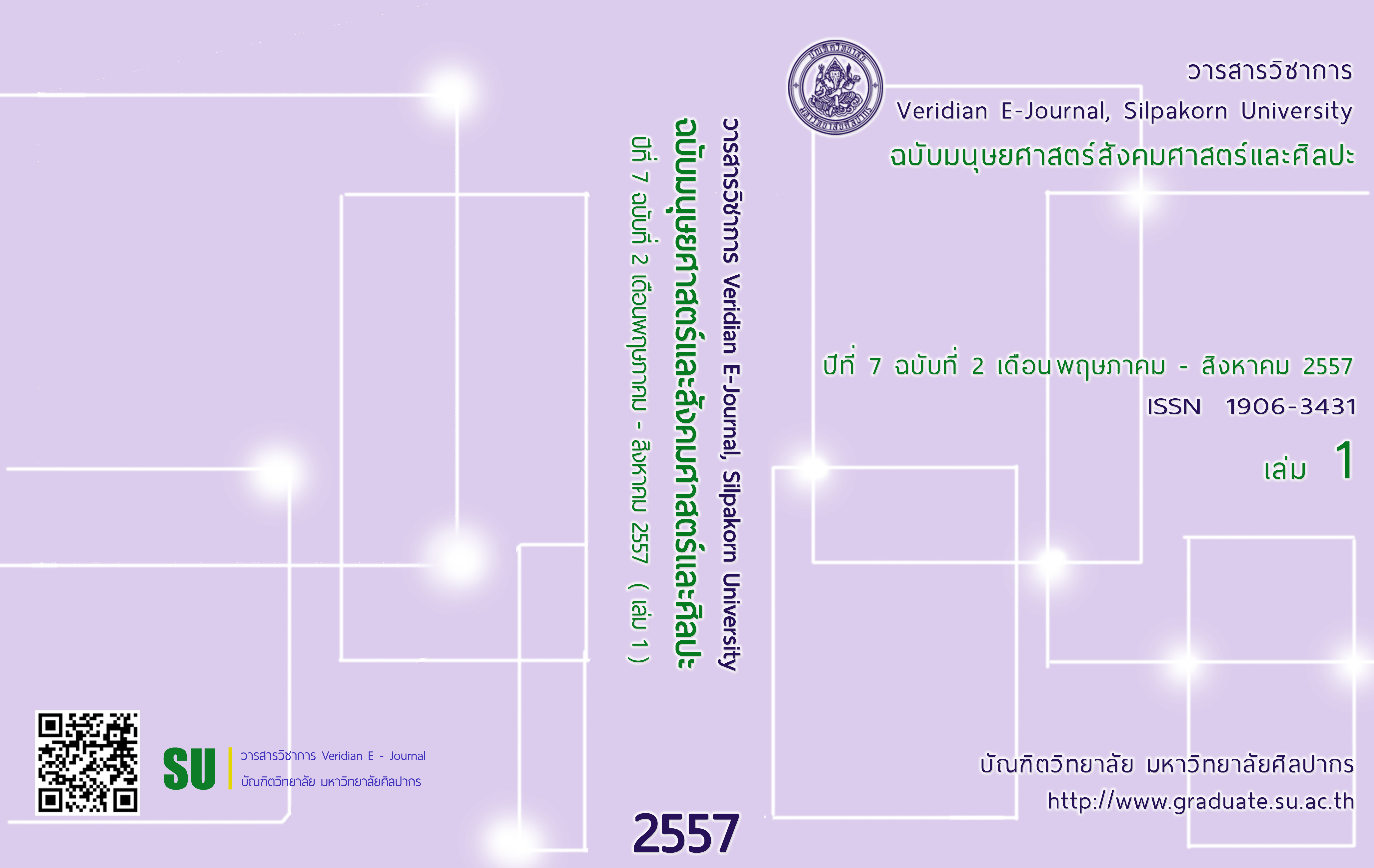การศึกษาผลการคิดวิเคราะห์และสัมฤทธิ์ทางการเรียนด้วยการเรียนแบบอีเลิร์นนิงโดยใช้การเรียนการสอนแบบกรณีศึกษา ของนักศึกษาระดับปริญญาตรี สาขาครุศาสตร์/ศึกษาศาสตร์ / A STUDY OF ANALYTICAL THINKING AND LEARNING ACHIEVEMENT VIA E-LEARNING USING CASE BASED LEARNIG
Main Article Content
Abstract
บทคัดย่อ
การวิจัยครั้งนี้มีวัตถุประสงค์เพื่อ 1) เพื่อเปรียบเทียบคะแนนความสามารถในการคิดวิเคราะห์ก่อนและหลังเรียนของนักศึกษากลุ่มเก่ง ปานกลาง และอ่อนที่จัดการเรียนการสอนด้วยอีเลิร์นนิงโดยการสอนแบบกรณีศึกษา 2) เพื่อเปรียบเทียบผลสัมฤทธิ์ทางการเรียนก่อนและหลังเรียนของนักศึกษา กลุ่มเก่ง ปานกลาง และอ่อน ที่จัดการเรียนการสอนด้วยอีเลิร์นนิงโดยการสอนแบบกรณีศึกษา 3) เพื่อศึกษาพฤติกรรมการเรียนของนักศึกษาที่จัดการเรียนการสอนด้วยอีเลิร์นนิงโดยการสอนแบบกรณีศึกษา 4) เพื่อศึกษาความคิดเห็นของนักศึกษาที่มีต่อการเรียนการสอนด้วยอี-เลิร์นนิงโดยการสอนแบบกรณีศึกษา
เครื่องมือที่ใช้ในการวิจัยประกอบด้วย 1) แบบสัมภาษณ์แบบมีโครงสร้าง 2) แผนการจัดการเรียนรู้ 3) บทเรียนอีเลิร์นนิงโดยใช้การเรียนการสอนแบบกรณีศึกษา 4) แบบประเมินความสามารถในการคิดวิเคราะห์ 5) แบบสังเกตพฤติกรรมการเรียนอีเลิร์นนิงโดยการสอนแบบกรณีศึกษา 6) แบบทดสอบวัดผลสัมฤทธิ์ทางการเรียน 7) แบบสอบถามความคิดเห็น สถิติที่ใช้ในการวิเคราะห์ข้อมูล ได้แก่ ค่าเฉลี่ย ( ) ส่วนเบี่ยงเบนมาตรฐาน (S.D.) และสถิติทดสอบค่าที (t-test)
ผลการวิจัยพบว่า
1. คะแนนความสามารถในการคิดวิเคราะห์ของนักศึกษากลุ่มเก่งที่จัดการเรียนการสอนด้วยอี-
เลิร์นนิงโดยการสอนแบบกรณีศึกษาก่อนเรียนสูงกว่าหลังเรียน คะแนนความสามารถในการคิดวิเคราะห์ของนักศึกษากลุ่มปานกลางและกลุ่มอ่อนที่จัดการเรียนการสอนด้วยอีเลิร์นนิงโดยการสอนแบบกรณีศึกษา หลังเรียนสูงกว่าก่อนเรียน อย่างมีนัยสำคัญทางสถิติที่ระดับ .05
2. ผลสัมฤทธิ์ทางการเรียนวิชาสื่อการศึกษา แหล่งเรียนรู้และสิ่งแวดล้อมเพื่อการเรียนรู้ ของนักศึกษากลุ่มเก่งที่จัดการเรียนการสอนด้วยอีเลิร์นนิงโดยการสอนแบบกรณีศึกษา ก่อนเรียนสูงกว่าหลังเรียน ผลสัมฤทธิ์ทางการเรียนวิชาสื่อการศึกษา แหล่งเรียนรู้และสิ่งแวดล้อมเพื่อการเรียนรู้ ของนักศึกษากลุ่มปานกลางและกลุ่มอ่อนที่จัดการเรียนการสอนด้วยอีเลิร์นนิงโดยการสอนแบบกรณีศึกษา หลังเรียนสูงกว่าก่อนเรียน อย่างมีนัยสำคัญทางสถิติที่ระดับ .05
3. พฤติกรรมการเรียนของนักศึกษาที่จัดการเรียนการสอนด้วยอีเลิร์นนิงโดยการสอนแบบกรณีศึกษา อยู่ในระดับดี ( = 24.61 และ S.D. = 1.24)
4. ความคิดเห็นต่อการเรียนการสอนด้วยอีเลิร์นนิงโดยการสอนแบบกรณีศึกษา อยู่ในระดับปานกลาง ( = 3.38 และ S.D. = 0.85)
Abstract
The purposes of this research were 1) to compare the analytical thinking of excellent student group, moderate student group and mild student group between before and after adoption of e-learning using case based learning method, 2) to compare the learning achievement of excellent student group, moderate student group and mild student group between before and after adoption e-learning using case based learning method, 3) to study behaviors of students taught via e-learning using case based learning method, and 4) to study the perspective of students in e-learning using case based learning method. The sample of this research were selected by multi– stage sampling method, consisted of 81 the second-year undergraduate students of Faculty of Education, who registered in 468 201 Educational Media Learning Resources and Learning Environment course in the first semester of academic year 2013 , Silpakorn University.
The instruments of this research were ; 1) a structured interviews, 2) lesson plans via e-learning using case based learning method, 3) e-learning using case based learning method, 4) analytical thinking assessment form, 5) the behavior in e-learning using case based learning method observation form, 6) the learning achievement test for Educational Media Learning Resources and Learning Environment Subject, and 7) questionnaire on student’ opinions on e-learning using case based learning method. The standard deviation and t-test dependent were used to analysis collected data.
The results of research were as follows:
1. The analytical thinking score of excellent student group between before adoption of e-learning using case based learning method is significantly higher than after adoption of e-learning using case based learning method and the analytical thinking score of moderate student group and mild student group between after adoption of e-learning using case based learning method is significantly higher than before adoption of e-learning using case based learning method at statistical significance level .05.
2. The learning achievement of excellent student group between before adoption e-learning using case based learning method is significantly higher than after adoption e-learning using case based learning method and the learning achievement of moderate student group and mild student group between after adoption e-learning using case based learning method is significantly higher than before adoption e-learning using case based learning method at statistical significance level .05.
3. The behaviors of students taught via e-learning using case based learning method is satisfactory ( = 24.61 and S.D. = 1.24).
4. The perspective of students in e-learning using case based learning method is average ( = 3.38 and S.D. = 0.85).
